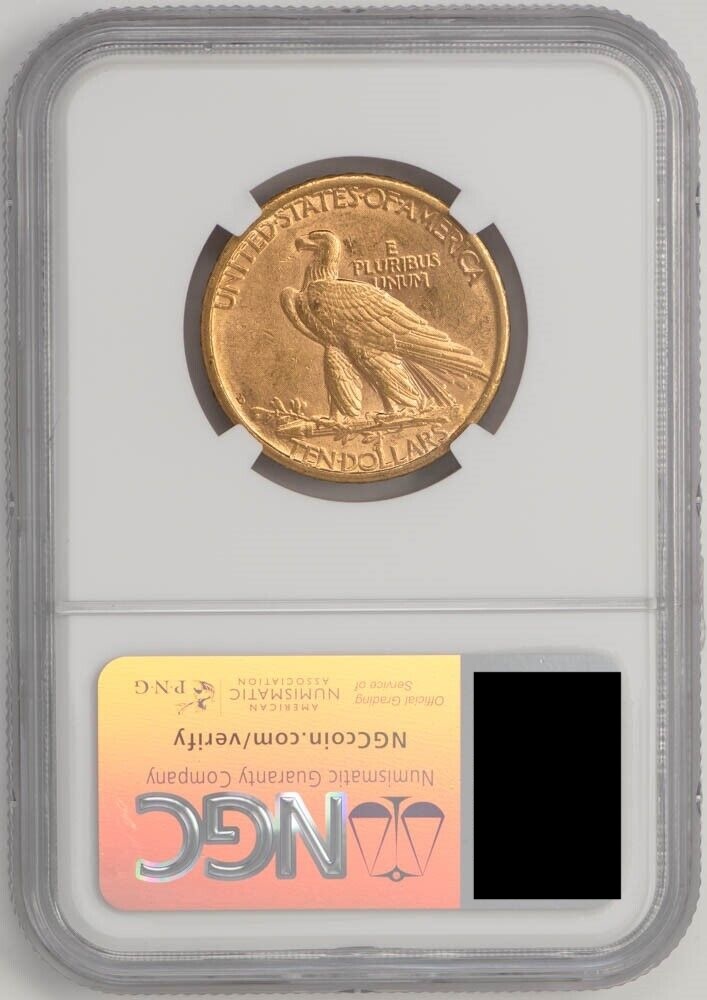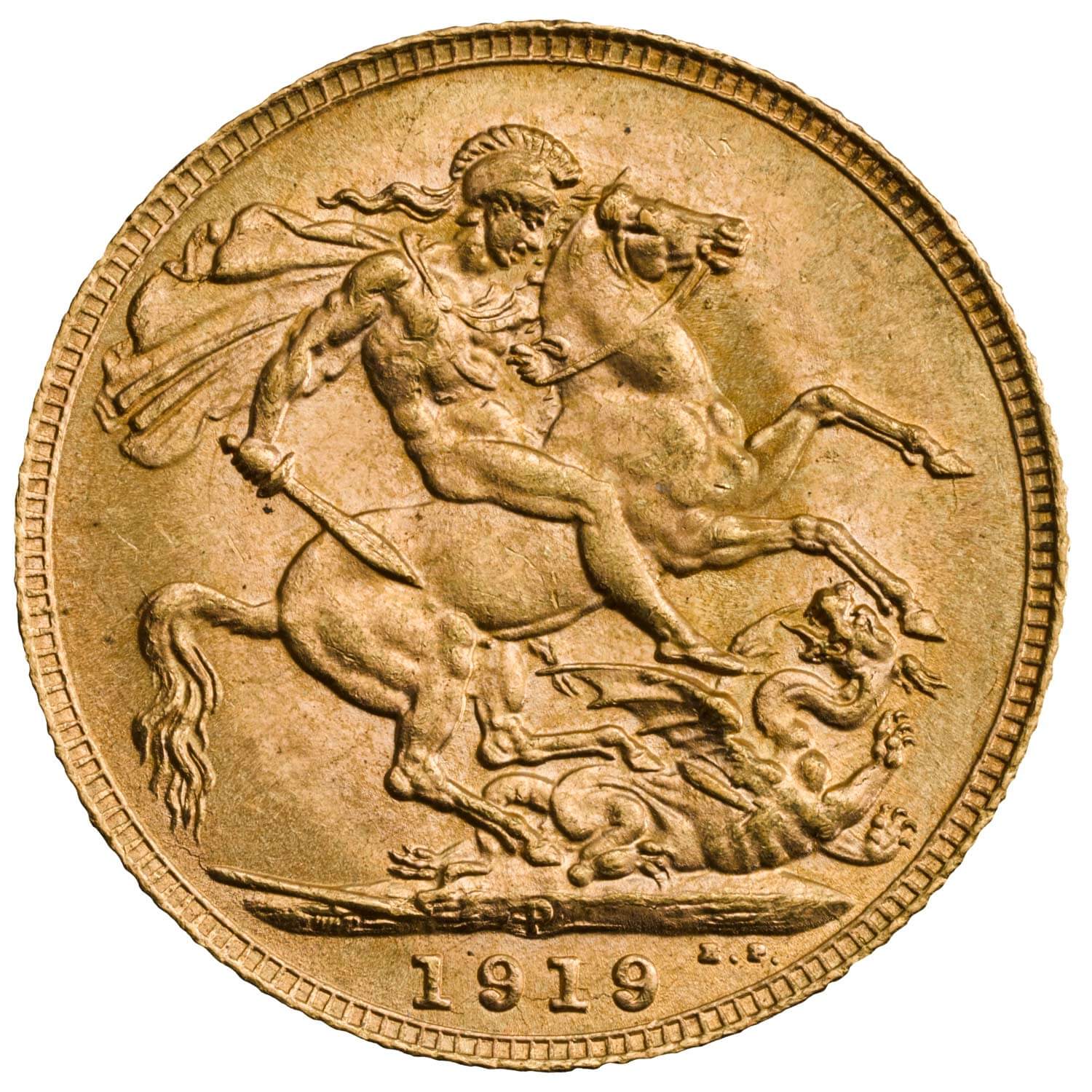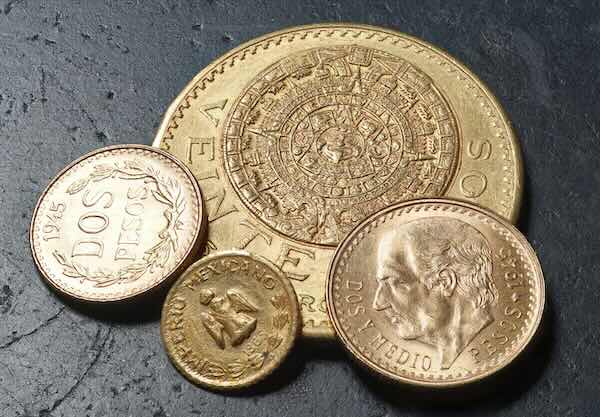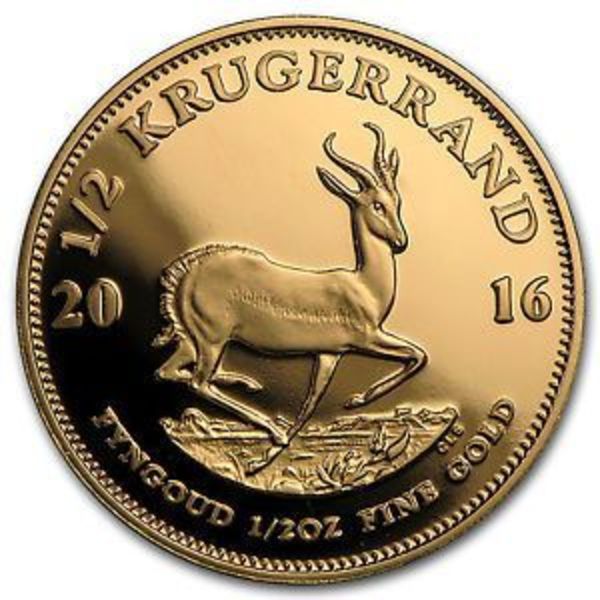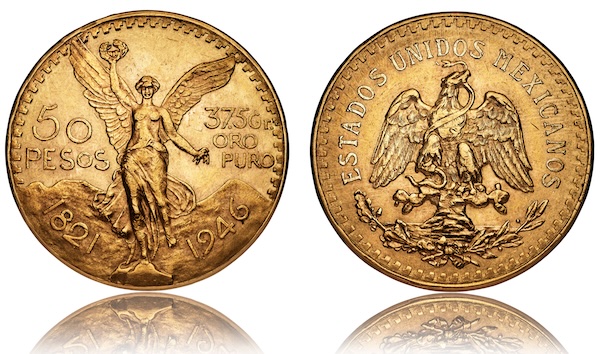Owning gold is pretty simple. Picking the right gold is not. The classic $10 Gold Coin, particularly the Liberty Head and Indian Head Eagles, sits right in the overlap between bullion and numismatics.
You’re buying almost a half ounce of gold, but you’re also buying a finite pre-1933 U.S. coin series that collectors care about and that the market has traded actively for more than a century.
What is the $10 Gold Coin?
The U.S. $10 Gold Coin, declared the Eagle in the Coinage Act of 1792 was a workhorse denomination of the gold standard era. First issued in 1795, it continued (with gaps and design changes) until 1933, when private gold ownership was heavily restricted under Executive Order 6102.
For modern buyers, two series dominate the market:
- Liberty Head $10 Gold Coin (1838–1907)
- Indian Head $10 Gold Coin (1907–1933)
Both:
- Contain 0.48375 troy ounces of gold in a 90% gold / 10% copper alloy
- Are widely recognized and actively traded by major dealers
- Have enough surviving common dates that they function as quasi-bullion
- Have scarcer dates and grades that are firmly numismatic plays
That combination — bullion floor + numismatic potential — is why these coins show up in both investment portfolios and serious collections.
Liberty Head $10 Gold Coin (1838–1907)
Design and Specifications
The Liberty Head $10 Gold Coin (often called the Coronet Head Eagle) was designed by Christian Gobrecht, the third Chief Engraver of the U.S. Mint.
Key points:
- Obverse: Left-facing Liberty wearing a coronet inscribed LIBERTY, surrounded by 13 stars and the date below.
- Reverse: Heraldic eagle with shield, holding arrows and olive branch, surrounded by UNITED STATES OF AMERICA and TEN D.; mintmark below eagle.
- Composition: 90% gold, 10% copper
- Gold content: 0.48375 troy oz
- Years struck: 1838–1907 (with subtype changes such as the addition of IN GOD WE TRUST in 1866) (PCGS)
Numismatically, certain dates and mintmarks are tough; but for most bullion-oriented buyers, “common date, random year” Liberty $10s are essentially a semi-numismatic gold vehicle with a strong collector following. PCGS and other price guides show deep collector markets but very modest premiums for generic, circulated common dates.
Premiums over spot for Liberty $10 Gold Coins
Based on your current pricing table and recent listings from large, reputable bullion dealers, we can map out realistic premium bands for common-date Liberty $10 Gold Coins (not key dates, not condition rarities).
Spot gold (from your data): $4,065.01 / oz
Representative Liberty $10 products & listed premiums:
- Liberty $10 Eagle Gold Coin (Random Year) – +1.20%
- $10 Liberty Eagle Gold Coin XF – +1.85%
- $10 Liberty Eagle Gold Coin (BU) – +3.29%
- $10 MS-60 Liberty Gold Eagle (PCGS/NGC) – +3.38%
- $10 Liberty Gold Eagle BU (Apmex) – +5.43%
Using these real-world quotes, here’s a practical premium table for common-date Liberty $10s:
Typical Premiums – Liberty Head $10 Gold Coin (Common Dates)
| Grade band / Market bucket | Typical % premium over spot* | How that translates in practice |
|---|---|---|
| VF–XF Circulated (“generic common”) | ~1.2% – 2.0% | Often sold as “Random Year” or specified XF; treated as semi-bullion by many dealers. |
| AU (Choice Circulated / AU50–AU58) | ~2.0% – 3.0% (est.) | Thin data point spread; usually prices fill the gap between XF and lower-MS coins. |
| BU / MS60–MS61 (uncertified or slabbed) | ~3.0% – 3.5% | Generic uncirculated commons; often marketed to both stackers and entry-level collectors. |
| Retail BU/MS62+ (branded “premium BU”) | ~3.5% – 5.5% | Higher eye-appeal offerings from big retailers; brand and marketing push premiums to top of band. |
*Premiums are relative to melt value of the gold content. Markets move; these ranges can and will change. In the current market, common-date pre-1933 U.S. gold is currently trading at multi-decade low premiums relative to spot.
3. Indian Head $10 Gold Coin (1907–1933)
Design and Specifications
The Indian Head $10 Gold Coin (Indian Head Eagle) was part of Theodore Roosevelt’s push to elevate U.S. coinage into true “national art.” Sculptor Augustus Saint-Gaudens created the design, which the Mint modified for mass production.
Key points:
- Obverse: Liberty wearing a Native American feathered headdress, LIBERTY across the band, with 13 stars and date.
- Reverse: Bald eagle standing on a bundle of arrows and an olive branch; UNITED STATES OF AMERICA, E PLURIBUS UNUM and IN GOD WE TRUST (added in 1908 after public pushback).
- Composition: 90% gold, 10% copper
- Gold content: 0.48375 troy oz (same as Liberty)
- Years struck: 1907–1933
NGC and PCGS both emphasize that truly high-grade Indian $10s (MS-65 and up) are legitimately scarce, while VF–AU commons are far more available and tend to trade with bullion-like behavior.
Premiums over spot for Indian $10 Gold Coins
From your pricing table and current dealer offerings:
- $10 Indian Eagle Gold Coin (VF) – +3.33%
- $10 Indian Head Gold Eagle (Circulated or Cleaned) – +3.90%
- $10 Indian Eagle Gold Coin BU – +3.77%
- $10 Indian Eagle Gold Coin AU – +5.32%
So, for common-date Indian $10 Gold Coins:
Typical Premiums – Indian Head $10 Gold Coin (Common Dates)
| Grade band / Market bucket | Typical % premium over spot* | How that translates in practice |
|---|---|---|
| VF–XF / Circulated / Cleaned (generic common) | ~3.3% – 4.0% | Often listed as “VF” or “Circulated/Cleaned”; still very liquid but carries a modest numis bump. |
| AU (problem-free, decent eye appeal) | ~4.0% – 5.5% | Appeals to crossover buyer: investor + collector; more sensitive to small grade differences. |
| BU / Choice Unc (raw or low-MS) | ~4.0% – 6.0% | Indian design is popular; even generic BU usually sells above Liberty at equivalent grades. |
*Again: premiums are relative to melt value of the gold content, based on current dealer quotes and the spot gold figure from your table. Future market levels may differ significantly.
Counterfeits and altered coins
Pre-1933 $10s are heavily counterfeited, including real-gold fakes and altered coins.
To manage that risk:
- Favor coins certified by PCGS or NGC for anything beyond low-grade generic.
- Buy from established dealers with strong reputations in both bullion and numismatics (not random online Facebook sellers).
Liquidity, Spreads and Condition
Even when premiums are low, spreads exist:
- You might pay +3–5% over melt and sell back at +0–2%, depending on market stress and dealer appetite.
- Local coin shops and online dealers sometimes pay closer to melt on generic material, especially in forced-selling environments.
- Grade drives value. Paying numismatic premiums for a coin that turns out to be over-graded, cleaned, or damaged is an easy way to lose money.
- If you’re paying serious numismatic money, stick to slabbed coins from top-tier services.
You should not assume you can instantly recover the full premium you paid.
5.4 Market and price risk
Gold prices can fall. Numismatic premiums can also shrink if:
- Demand shifts to other series
- A wave of supply hits (estate liquidations, meltbacks reversing)
- Economic conditions change and buyers prioritize tight-spread bullion
None of these coins guarantee profit. They’re tools for wealth preservation, diversification, and collecting, not a quick flip.
7. Bottom Line
Right now, common-date $10 Gold Coins — especially Liberty Head and Indian Head Eagles — are priced in a way that blurs the line between bullion and collectible:
- Liberty $10s often sit in the +1–3% over melt band for VF–AU
- Indian $10s typically run +3–5% for VF–AU
- Choice BU and low-MS coins push into the mid-single-digit premium range
That’s historically low for pre-1933 U.S. gold and creates a window for bullion investors to add historic coins without paying old-school numismatic markups.
Still, you should treat them as part of a broader strategy, not your entire plan. Double-check pricing, confirm authenticity, and consider speaking with a qualified financial or tax professional if you’re making large allocations.
Sources (Authoritative & Numismatic-Focused)
- PCGS CoinFacts – Liberty Head $10 (1838–1907): design, specs, and historical notes (PCGS)
- PCGS Price Guide – Liberty Head $10 values by grade and date (PCGS)
- NGC Coin Explorer – Indian Head $10 (1907–1933): specifications, varieties, and grading notes (NGC Coin)
- NGC Melt Value & Price Tools – U.S. gold coin melt values and trends (NGC Coin)
- APMEX – Pre-1933 U.S. Gold Coins and Premiums on Pre-1933 Gold (market structure and long-term premium behavior) (APMEX)
- SD Bullion – Pre-1933 U.S. Gold Coins and specific product pages for $10 Liberty and $10 Indian Eagles (investor-focused descriptions) (SD Bullion)
- Bullion Exchanges – Category pages for $10 Liberty and $10 Indian Head Gold Coins (current retail trading context) (Bullion Exchanges)
- American Numismatic Association (ANA) – Educational resources and research tools for grading and valuation (American Numismatic Association)
If you want, I can next:
- Add a short FAQ section targeting “$10 Gold Coin” search queries, or
- Draft a separate piece focused purely on how to spot fakes and cleaned coins in this series.
Everything here is educational, not individualized financial advice. You should always match any gold purchase to your own risk tolerance, time horizon, and overall financial plan.
Owning and appreciating gold coins can be both a collection and an investment. For some, the intention is towards the historical and aesthetic value of the coins. For others, the focus is on the potential appreciation of the coins’ value over time. Investing in $10 Eagle gold coins is relatively straightforward, especially for those interested in numismatics or tangible assets.
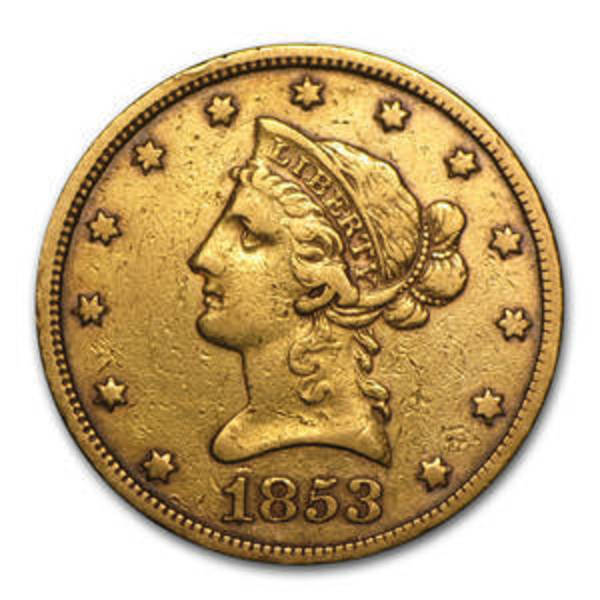
The $10 Eagle gold coin contains 0.48375 troy ounces of gold and is made from an alloy of 90% gold and 10% copper. As tangible assets, these coins are valued not only for their gold content but also for their historical and collectible value.
The $10 Eagle was minted from 1795 until 1933, when FDR declared that all gold should be seized, melted down, and held as reserves in the Fort Knox Bullion Depository.
Three significant designs were issued in different eras throughout the years of minting.
- The Capped Bust Series from 1795-1804
- The Liberty Series or Coronet Head from 1838-1907
- The Indian Head Series from 1907 until 1933
Capped Bust $10 Eagle (1795-1804)
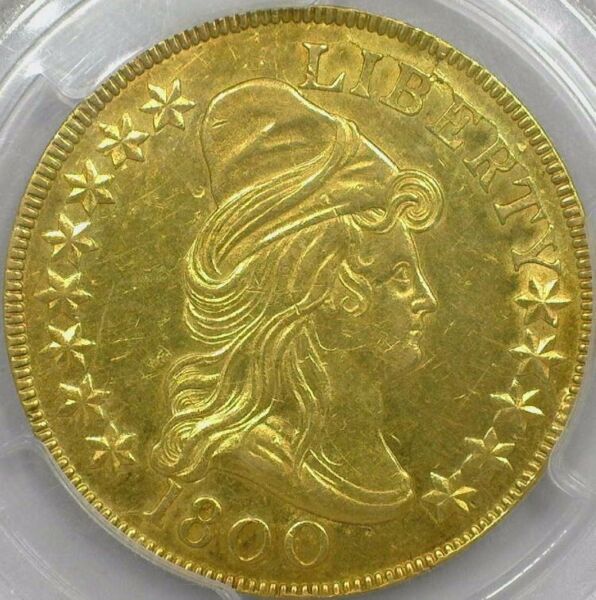
Value: more than $21,000
The Turban Head $10 Gold Eagle coin, also known as the Draped or Capped Bust Eagle, was a series of gold coins minted by the United States Mint from 1795 to 1804. The designer of this coin was Robert Scot, the first Chief Engraver of the United States Mint.
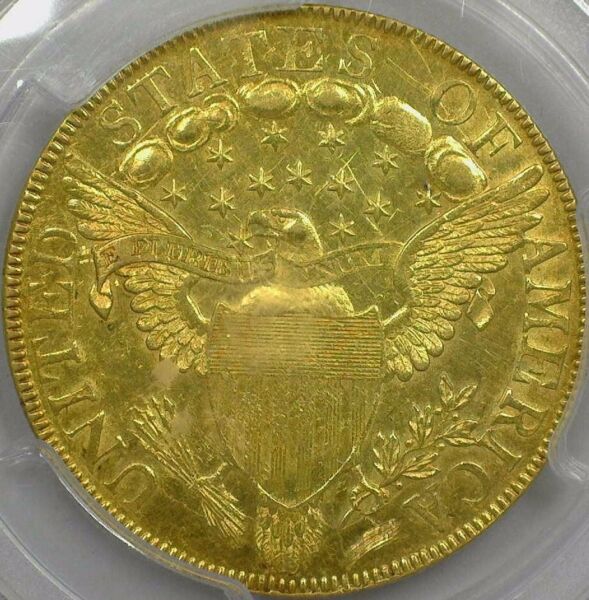
The Turban Head Eagle featured a portrait of Lady Liberty wearing a turban-like cap on the obverse, while the reverse showcased a bald eagle with a shield on its chest.
In the early years, the mintage of these coins was extremely low. The first mintage to exceed 10,000 coins was in 1799 when the Mint issued 37,449 $10 gold coins.
Liberty Head Series (1838-1907)
Christian Gobrecht designed the Liberty Gold series and became the third Chief Engraver of the U.S. Mint.
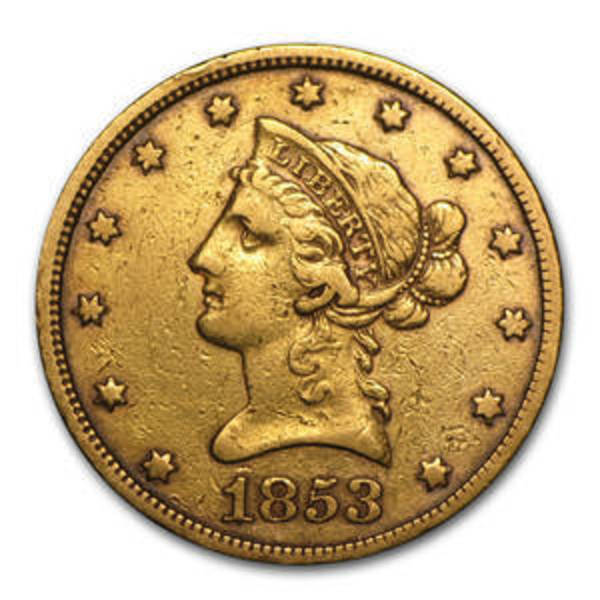
Neoclassical art was prevalent during his time, and style inspired this rendition of Lady Liberty.
The design of the Liberty Head $10 Gold Eagle was inspired by the portrait of Venus in Benjamin West’s Painting Omnia Vincit Amor (Love Conquers All).
It features a bust of Liberty facing left, wearing a coronet inscribed LIBERTY with thirteen stars encircling the bust and the date positioned below. Her hair hangs in curls with a knot in the back.
The reverse depicts an eagle holding an olive branch and arrows, surrounded by the inscriptions UNITED STATES OF AMERICA and TEN D. Mintmarks are situated below the eagle.
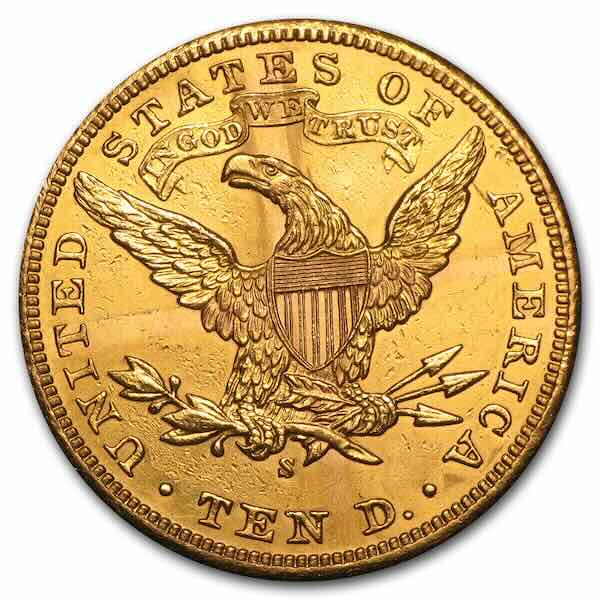
President Theodore Roosevelt was not a fan of the Liberty series. He considered the designs to be unattractive and lacking in artistic merit.
Roosevelt’s quest for coins that reflected the nation’s grandeur led to the commissioning of renowned sculptor Augustus Saint-Gaudens, culminating in the 1907 introduction of the Indian Head $10 Eagle Gold Coin.
Indian Head Eagle Gold Coin (1907-1933)
The Indian Head $10 Eagle gold piece was minted from 1907 to 1933.
The overall design of the $10 Indian gold coin is highly detailed and intricate, a testament to the era’s American spirit, artistry, and craftsmanship.
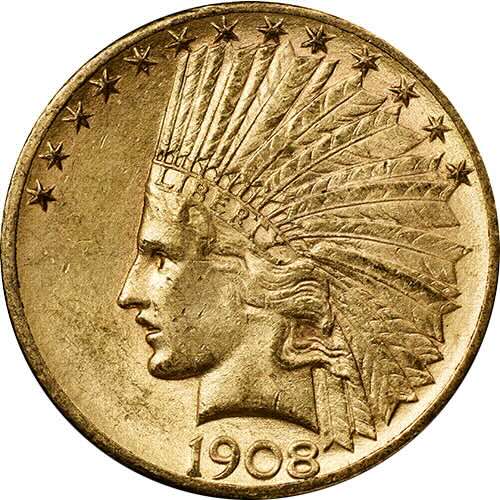
The public had mixed reactions to the design of the Indian Head $10 Eagle gold piece in 1907. The most contentious point was omitting the motto “IN GOD WE TRUST” on the initial coins.
Teddy Roosevelt penned a famous letter explaining his feelings, favoring keeping the motto off the coin.
However, the U.S. Mint responded to the public’s concern, and the motto was added to the coin in 1908.
Less than 450,000 coins of the NO MOTTO variant of the Indian Head $10 Gold coin were minted before the U.S. Mint updated the design. How many of these coins survived the 1933 gold seizure is unknown.
In today’s market, these coins are rare, and some variants in higher Mint State (M.S.) conditions can fetch up to $100,000 at auction.
Meanwhile, coins in lower Mint State condition, such as MS-63, are more affordable and have room to appreciate.
The coin’s obverse features a unique and iconic design of Lady Liberty, inspired by the Greek goddess Nike. She is depicted wearing a Native American headdress, symbolizing the American West. Augustus Saint-Gaudens created this design, which was adapted for the coin. The word “LIBERTY” is inscribed on the headband of the headdress, and the year of issue is at the bottom.
The coin’s reverse showcases a bald eagle perched on a bundle of arrows and olive branches. This design represents both the country’s strength and its peace-loving nature.
The motto “E PLURIBUS UNUM” (meaning “Out of Many, One”) is inscribed on the left, and the denomination “TEN DOLLARS” is on the right. The words “UNITED STATES OF AMERICA” encircle the top of the design, with the motto “IN GOD WE TRUST” added in 1908, positioned to the eagle’s left.
